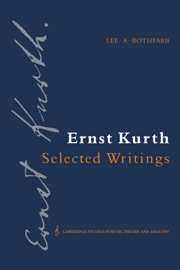Book contents
- Frontmatter
- Contents
- Foreword by Ian Bent
- Preface
- Notes on the translation
- Introduction
- Part I Grundlagen des linearen Kontrapunkts (Foundations of linear counterpoint)
- Part II Romantische Harmonik und ihre Krise in Wagners “Tristan” (Romantic harmony and its crisis in Wagner's “Tristan”)
- 4 Details of Romantic harmony
- 5 Broader dimensions of Romantic harmony
- Part III Bruckner
- Appendix: Complete tables of contents for Kurth's Grundlagen des linearen Kontrapunkts, Romantische Harmonik und ihre Krise in Wagners “Tristan” and Bruckner
- Select bibliography
- Index of musical examples
- General index
4 - Details of Romantic harmony
Published online by Cambridge University Press: 10 December 2009
- Frontmatter
- Contents
- Foreword by Ian Bent
- Preface
- Notes on the translation
- Introduction
- Part I Grundlagen des linearen Kontrapunkts (Foundations of linear counterpoint)
- Part II Romantische Harmonik und ihre Krise in Wagners “Tristan” (Romantic harmony and its crisis in Wagner's “Tristan”)
- 4 Details of Romantic harmony
- 5 Broader dimensions of Romantic harmony
- Part III Bruckner
- Appendix: Complete tables of contents for Kurth's Grundlagen des linearen Kontrapunkts, Romantische Harmonik und ihre Krise in Wagners “Tristan” and Bruckner
- Select bibliography
- Index of musical examples
- General index
Summary
This chapter contains excerpts from Romantische Harmonik und ihre Krise in Wagners “Tristan”, 3rd edn., part 3 (“From the cadence to the alteration style of Tristan”), the largest section of the book, and from part 4 (“Paths of harmonic development”). Parts 1 and 2, the background for parts 3 and 4, interpret Romantic harmony psychologically, present the psychological bases of Romantic music in general (part 1, “Foundations”), and give a thorough analytic account of the Tristan chord and its various resolutions, enharmonic transformations, and symbolic meanings (part 2, “The first chord”). Part 3 presents specific harmonic techniques by expanding on the analytic findings of part 2, and parts 4 and 5 show the escalation of early nineteenth-century practices into those of the late nineteenth century.
The passages translated here deal with harmonic “contrasting” and “shading” (part 3, chapters 3 and 4, “Heightened harmonic coloring,” “Harmonic shading,” pp. 150–51, 153–55, 159–67); with melodic and harmonic alteration of chords, and distorted root progression (part 3, chapter 5, “The intensive alteration style,” 183–86, 189–91, 199–201, 205–6, 210–11); and with “absolute” chords and chord progressions, including mediant progressions (part 4, chapter 2, “The interior dissolution of color in romantic harmony,” 262–70, 270–77, 297–99, 301–5).
Readers should keep in mind that, for the most part, Kurth's analyses in Romantische Harmonik examine local-level harmonic details.These details often have broader implications, some of which Kurth explores in other portions of the book.
- Type
- Chapter
- Information
- Ernst Kurth: Selected Writings , pp. 99 - 129Publisher: Cambridge University PressPrint publication year: 1991
- 1
- Cited by

